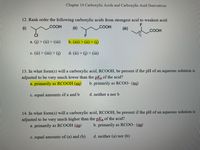
Chemistry
10th Edition
ISBN: 9781305957404
Author: Steven S. Zumdahl, Susan A. Zumdahl, Donald J. DeCoste
Publisher: Cengage Learning
expand_more
expand_more
format_list_bulleted
Concept explainers
Question
Questions 12, 13, 14

Transcribed Image Text:Chapter 14 Carboxylic Acids and Carboxylic Acid Derivatives
12. Rank order the following carboxylic acids from strongest acid to weakest acid:
(i)
COOH
(ii)
.COOH
(ii)
COOH
a. (i) > (ii) > (ii)
b. (iii) > (ii) > (i)
c. (ii) > (iii) > (i)
d. (ii) > (i) > (iii)
13. In what form(s) will a carboxylic acid, RCOOH, be present if the pH of an aqueous solution is
adjusted to be very much lower than the pKa of the acid?
a. primarily as RCOOH (ag)
b. primarily as RCO0- (ag)
c. equal amounts of a and b
d. neither a nor b
14. In what form(s) will a carboxylic acid, RCOOH, be present if the pH of an aqueous solution is
adjusted to be
a. primarily as RCOOH (ag)
very
much higher than the pKa of the acid?
b. primarily as RCOO- (ag)
c. equal amounts of (a) and (b)
d. neither (a) nor (b)
Expert Solution
arrow_forward
Step 1
An acid is called strong acid when it's conjugate base after deprotonation is most stable ,here electronegative atom stabilizes acids hence Higher the electronegativity higher is acidic strength
Trending nowThis is a popular solution!
Step by stepSolved in 4 steps with 2 images

Knowledge Booster
Learn more about
Need a deep-dive on the concept behind this application? Look no further. Learn more about this topic, chemistry and related others by exploring similar questions and additional content below.Similar questions
- Suppose that you heated the hydrated copper (II) sulphate in a test tube, instead of a beaker. How might this affect your results? 4 MAY 19 ... MacBook Pro & * %23 $ 2 3 4 5 6 7 E Y U G H J K C V M MOSISO command option command レーarrow_forwardThe Bunsen burner is needed in the experiment to heat the water but not the metal. Question 4 options: True Falsearrow_forwardName the following Fe(NO3)2arrow_forward
arrow_back_ios
arrow_forward_ios
Recommended textbooks for you
 ChemistryChemistryISBN:9781305957404Author:Steven S. Zumdahl, Susan A. Zumdahl, Donald J. DeCostePublisher:Cengage Learning
ChemistryChemistryISBN:9781305957404Author:Steven S. Zumdahl, Susan A. Zumdahl, Donald J. DeCostePublisher:Cengage Learning ChemistryChemistryISBN:9781259911156Author:Raymond Chang Dr., Jason Overby ProfessorPublisher:McGraw-Hill Education
ChemistryChemistryISBN:9781259911156Author:Raymond Chang Dr., Jason Overby ProfessorPublisher:McGraw-Hill Education Principles of Instrumental AnalysisChemistryISBN:9781305577213Author:Douglas A. Skoog, F. James Holler, Stanley R. CrouchPublisher:Cengage Learning
Principles of Instrumental AnalysisChemistryISBN:9781305577213Author:Douglas A. Skoog, F. James Holler, Stanley R. CrouchPublisher:Cengage Learning Organic ChemistryChemistryISBN:9780078021558Author:Janice Gorzynski Smith Dr.Publisher:McGraw-Hill Education
Organic ChemistryChemistryISBN:9780078021558Author:Janice Gorzynski Smith Dr.Publisher:McGraw-Hill Education Chemistry: Principles and ReactionsChemistryISBN:9781305079373Author:William L. Masterton, Cecile N. HurleyPublisher:Cengage Learning
Chemistry: Principles and ReactionsChemistryISBN:9781305079373Author:William L. Masterton, Cecile N. HurleyPublisher:Cengage Learning Elementary Principles of Chemical Processes, Bind...ChemistryISBN:9781118431221Author:Richard M. Felder, Ronald W. Rousseau, Lisa G. BullardPublisher:WILEY
Elementary Principles of Chemical Processes, Bind...ChemistryISBN:9781118431221Author:Richard M. Felder, Ronald W. Rousseau, Lisa G. BullardPublisher:WILEY

Chemistry
Chemistry
ISBN:9781305957404
Author:Steven S. Zumdahl, Susan A. Zumdahl, Donald J. DeCoste
Publisher:Cengage Learning

Chemistry
Chemistry
ISBN:9781259911156
Author:Raymond Chang Dr., Jason Overby Professor
Publisher:McGraw-Hill Education

Principles of Instrumental Analysis
Chemistry
ISBN:9781305577213
Author:Douglas A. Skoog, F. James Holler, Stanley R. Crouch
Publisher:Cengage Learning

Organic Chemistry
Chemistry
ISBN:9780078021558
Author:Janice Gorzynski Smith Dr.
Publisher:McGraw-Hill Education

Chemistry: Principles and Reactions
Chemistry
ISBN:9781305079373
Author:William L. Masterton, Cecile N. Hurley
Publisher:Cengage Learning

Elementary Principles of Chemical Processes, Bind...
Chemistry
ISBN:9781118431221
Author:Richard M. Felder, Ronald W. Rousseau, Lisa G. Bullard
Publisher:WILEY